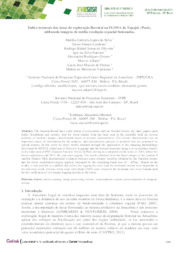Índice texturais das áreas de exploração florestal na FLONA do Tapajós (Pará), utilizando imagens de média resolução espacial fusionadas.
Índice texturais das áreas de exploração florestal na FLONA do Tapajós (Pará), utilizando imagens de média resolução espacial fusionadas.
Author(s): SILVA, M. G. L. da; CORDEIRO, T. F.; OLIVEIRA, R. R. S. de; NARVAES, I. da S.; GOMES, A. R.; ADAMI, M.; FREITAS, L. J. M. de; VALERIANO, D. de M.
Summary: The Amazon Biome has a wide variety of ecosystems, such as: flooded forests, dry land, igapós, open fields, floodplains and cerrado. And for forest studies what has been used in the scientific field are several methods of satellites images classification based on textural characteristics. The texture characteristics are an important source of information for the analysis and interpretation process of products that are generated by optical sensors. In this work we show results obtained through the application of the mapping methodology developed by DETEX (Detection of Selective Logging) and the textural measures using a co-occurrence matrix, in the study area of FNT (Tapajós National Forest) in Pará, having as a temporal cut the years of 2014, before the forest exploitation and 2015, the year post logging. The results obtained from the fused images of the Landsat 8 satellite (Sensor OLI) demonstrated a relation between some textural variables obtained by the Haralick texture and the forest exploitation degree applied, measured by the remaining basal area (G - m²/ha) . Based on the results, it was possible to establish that before the logging the trees from the dominant extract were important in the detection result, whereas when some individuals (2015) were extracted, the dominant trees were fundamental for the verification of low impact logging activity in the forest
Publication year: 2017
Types of publication: Paper in annals and proceedings
Unit: Embrapa Eastern Amazon
Keywords: Processamento de imagens, Sensoriamento Remoto, Textura
Observation
Some of Embrapa's publications are published as ePub files. To read them, use or download one of the following free software options to your computer or mobile device. Android: Google Play Books; IOS: iBooks; Windows and Linux: Calibre.
Access other publications
Access the Agricultural Research Database (BDPA) to consult Embrapa's full library collection and records.
Visit Embrapa Bookstore to purchase books and other publications sold by Embrapa.

